Many studies have been made and published related to wind resistance of Green Roofs, but in reality there is still a lack of consensus in the international green roofing / building industry on what kind of testing and certification would be most appropriate and representative of real wind effects on vegetated roofs.
Physics behind wind-suction
If we first look at the facts, we don’t often hear of green roofs having been blown-off during storms. Such an event might happen with pavers, waterproofing and similar, but this is not the case with green roofs.
But do we know why?
If we consider the physical components of the wind-suction effect, we know that when the wind blows over the roof certain negative pressure areas (vertigos) are created. These forces are able to grab and tear elements from the roof if they are too light or if they are not fixed firmly enough to the basic roof surface (Picture 1)
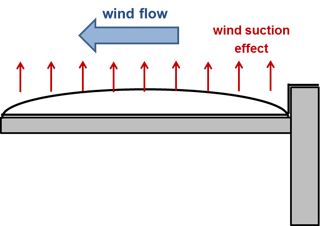
Picture 1 – effect of wind on regular flat roof surface
If we look at waterproofing, we need to do one of three things in order to keep it in place:
– Ballast it with gravel / tiles
– Physically, mechanically fix it
– Glue it to the roof surface (with PU / hot bitumen)
Why does the same not happen to Green Roofs?
There are several factors that differ when wind forces impact green roofs, the most important of which is the permeability of the green roof surface. Vegetation and growing media have open structures with many open spaces and irregularities that prevent the wind’s negative pressure vertigos from gaining a strong grip. The total negative pressure affecting the green roof surface is distributed such that the final effect represents only a fraction of the real forces impacting a regular roof (Picture 2).
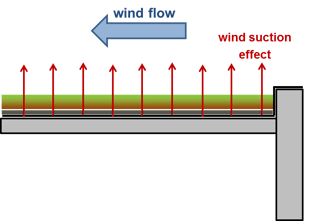 Picture 2 – effect of wind on green roof surface
Picture 2 – effect of wind on green roof surface
We know the physics - so what kind of testing would be appropriate?
There still is no consensus as to what should actually be monitored. Do we simply want to know what part of a vegetated roof will not fly away during a severe storm and hurt someone (safety factor); or do we want to know how much damage will be done to the vegetation (visual factor)? For the purposes of the building / roofing industry, wind up-lift testing should focus on safety measures, which should be our number one priority, so I want to focus on that. Let me just point out the main concerns and try to identify and summarise some of the key points that are making some global consensus on green roof wind up-lift testing such a challenge.
Real life (in-situ) vs. laboratory testing
1. Real life / In-situ testing and monitoring
These tests usually last a long time and are the best as they represent real-life situations in specific geographic / climatic areas. The main drawback, however, is the distinct likelihood that the testing period will not see any extreme wind situations – so the quality of the final test result is questionable. Also, there are so many different green roof & roof designs with their own specific characteristics that real-life testing should not be considered due to the complexity, cost and duration of the process. In my opinion, they should only be used to help confirm lab test results from real-life monitoring.
2. Laboratory testing
Laboratory tests are then (as always) the best option owing to several factors:
- fast
- easy to test in extreme situations
- allow us to test many different applications, installations, and types of green roof designs where both time and funds are limited
- are easily standardised globally
There could be some drawbacks as well, as they don’t necessary mimic real life situations, but this is something that needs to be tackled up-front, in the design stage of the test protocols.
Looking into current testing practices, there are two types of lab tests that are mostly widely used by the green roof industry:
a. Negative pressure test
This test protocol comes from the waterproofing / roofing industry. During the test, negative pressure is applied to the roof surface / waterproofing until the waterproofing membrane becomes detached from the base roof surface and is lifted off (sucked away from the surface). The same test protocol can also be applied to the Green Roof System.
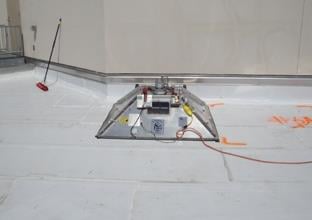 Picture 3 – Negative pressure test
Picture 3 – Negative pressure test
This type of test protocol is well respected and recognised in Germany. The bulk of the wind uplift design approach presented by the FLL (German – Guideline for the Planning, Execution, and Upkeep of Green Roofs) consists primarily in first calculating the building’s wind loads in accordance with European standards and in line with the above testing procedure. FLL states that the overall design uplift load results of the test should naturally decrease with the use of green roof systems due to effects that are the result of a combination of factors associated with green roofs. These factors include the coarseness of the vegetation, additional dead loads from residual substrate moisture and vegetation, the root system’s ability to bind growth media, and the wind permeability of the vegetation. (Vo, 2013)
As the guideline does not explicitly list any correction factors (as there are as many variables as there are different green roof systems) each system should be tested separately and theoretical correction factors calculated.
b. Wind-tunnel test
This test tries to model real life wind situations.
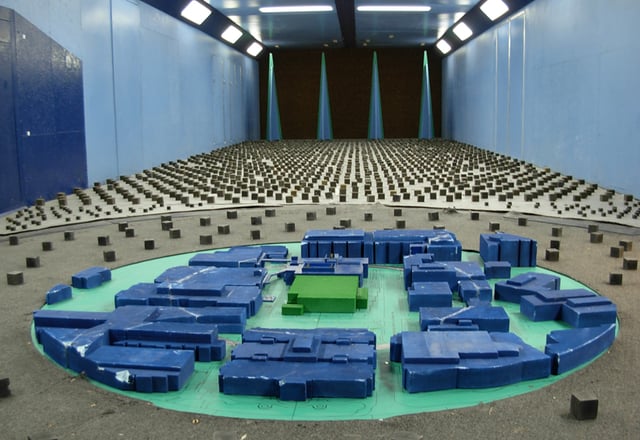
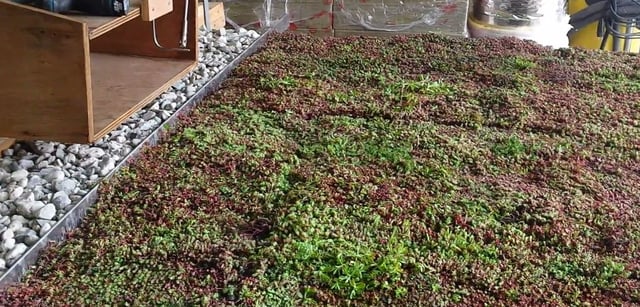
Pictures 4 and 5 – Wind tunnel test
The wind tunnel tests are more commonly used in North America. Many institutes have been performing wind tunnel tests on green roofs, and Canada is the first country to employ a standard method for testing wind uplift on vegetated roofs.
The most advanced wind tunnel wind uplift tests are being conducted at the NRC's Dynamic Roofing Facility in Ottawa, Canada, using a chamber fan mechanism that simulates the dynamic effects of wind.
Results from this kind of testing have proven very accurate. These tests provide precise wind speed measurements – so if the test shows that a green roof will be blown away at 170 km/h / 100 mph then it should be taken as fact. It is very straightforward, with no complex calculations or correction factors required.
Real life example showing the complexity of the topic
Recently we set up a lightweight green roof (25 kg/m2 = cca 5 lbs/ft2) in an area close to the Slovenian-Italian border, where the strong Bora wind (Burja in Slovenian, Boura in Italian) is common. It blows from the north/ northeast, and is the result of cold Alpine air colliding with warm, humid air from the Mediterranean, with wind speeds regularly exceeding 200 km/h (120 mph).
The roof was set up in the small town of Ajdovščina, where the highest speed ever officially recorded exceeded 300 km/h / 180 mph on 1 November 2010 (Wikipedia). It is unlikely this will happen again any time soon; however, just two weeks after setting up the green roof, winds close to 160 km/h (100 mph) blew through the area.
The results
This is what happened to a truck parked next to the building. The trailer was damaged, as well as the cargo packed inside.

And this is what happened to the green roof – no damage was sustained. Only a single Sedum blanket was moved a little, as the roots had not yet established a firm hold in the mineral fibre growing media below.
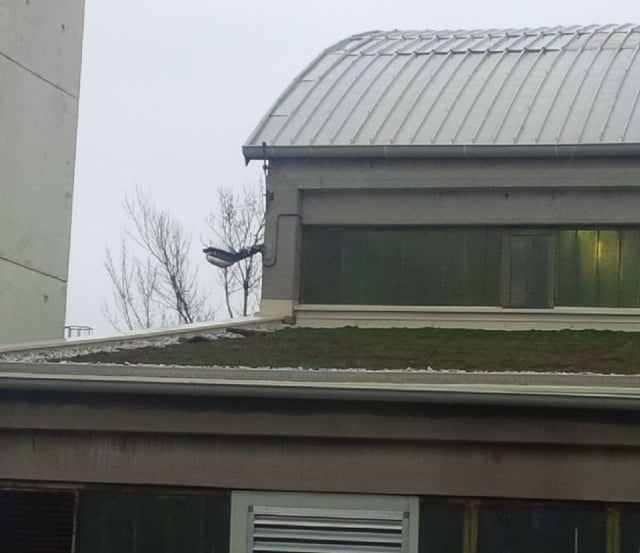
What's next?
It seems that the way forward is quite obvious. The Green Roofing Industry needs to work together with the building industry to determine the best method for testing vegetated roofs. Simply sticking to the old methods will not help the development of the green roofing sector. We need to have real performance data that will support faster future development of urban green infrastructures in which green roofs play an integral part.
Have you ever asked yourself why there are so many more green roofs installed on new buildings, but not on those that have been refurbished? The answer is simple: because existing roof construction standards are employed, which don’t take into account the specifics of green roofs. They talk about mandatory weights required on the green roof in order that they comply with building standards, but don’t necessarily consider practical wind up-lift resistance.
What about other green roofs performance factors?
- Energy performance in summer (cooling effect)
- Energy performance in winter (thermal insulation)
- Rainwater or stormwater management performance
- Performance in reducing the heat island effect
Download one of our selected Performance Evaluation Tool Reports, Urbanscape Green Roof System brochure or check our website to learn more about green roof benefits.
Source:
- Tuan.D.Vo, University of Florida, Full-Scale Wind Loading on Green Roof System, http://ufdc.ufl.edu/UFE0046353/00001
- WIKIPEDIA, https://sl.wikipedia.org/wiki/Burja




